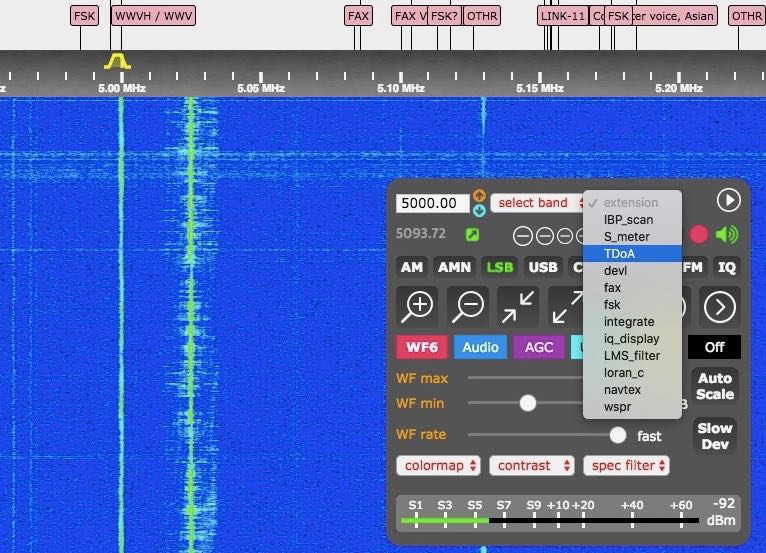There has been some fascinating functionality added to the excellent KiwiSDR network of online software defined radios: Time Difference of Arrival (TDoA) direction-finding functionality.
RTL-SDR.com has posted an informative article about this new feature and how effectively it works:
The KiwiSDR is a US$299 HF SDR that can monitor the entire 0 – 30 MHz band at once. It is designed to be web-based and shared, meaning that the KiwiSDR owner, or anyone that they’ve given access, can tune and listen to it via a web browser over the internet. Many public KiwiSDRs can be found and browsed from the list at sdr.hu or by signal strength and location on this website.
One thing that KiwiSDRs have is a GPS input which allows the KiwiSDR to run from an accurate clock, as well as providing positional data. Time Difference of Arrival (TDoA) is a direction finding technique that relies on measuring the difference in time that a signal is received at over multiple receivers spread out over some distance. In order to do this an accurate clock that is synchronized with each receiver is required. GPS provides this and is able to accurately sync KiwiSDR clocks worldwide.
Just recently all KiwiSDRs were pushed with a beta update (changelog) that enables easy TDoA direction finding to be performed with them. Since many KiwiSDRs are public, this means that right now anyone can browse to a KiwiSDR web interface and start a direction finding computation. You don’t even need to own a KiwiSDR to do this so this is the first freely accessible RF direction finding system available to the public.[…]
Of course, as the KiwiSDR network grows, TDoA accuracy will increase.
If you’d like to host your own KiwiSDR, you can purchase the full setup at SeedStudio or Amazon.com for $299 US (affiliate link).
Check out RTL-SDR.com’s full article and TDoA tests by clicking here.


What a fascinating new functionality! It seems natural that a network of SW SDRs can do the same as a network of ADS-B receivers, in theory you just need 4 (?) receivers for multilateration to give you a good hint on where that pesky OTH radar might be from (or that annoying guy on 80m, I guess we all have one of those), or just get a rough idea on any UNID signal’s origin.
And that’s just yet another incredible thing that only intelligence agencies etc. had in their arsenal before SDR technology got in average Joe’s hands. 🙂
Also see the brandnew Klingenfuss USB stick gives you more than 14,700 (fourteen thousand seven hundred!) digital data decoder screenshots from his continuous HF radio monitoring between 1968 and 2018!
http://www.klingenfuss.org/homepage.htm
He’s being going on trips and using HU-SDR sets to map out and list hundreds of thousands of utility and broadcast signals around the world. Essentia
[ I hate reCAPTCHA ]
Would be nice if we could “give” Kiwi SDRs to the “Dark Areas” of the world to hear/detect other locations.
Certainly the plethora of antennas on top of various embassies and consulates around the world indicate that many governments have such a system, though not for public use
For a while I had just that: a program that placed free Kiwis in under-represented areas of the world. Ultimately only 1/4 of the 20 units I sent out remained on the air long-term. Very disappointing. I guess people only really care when they have their own money in the game.